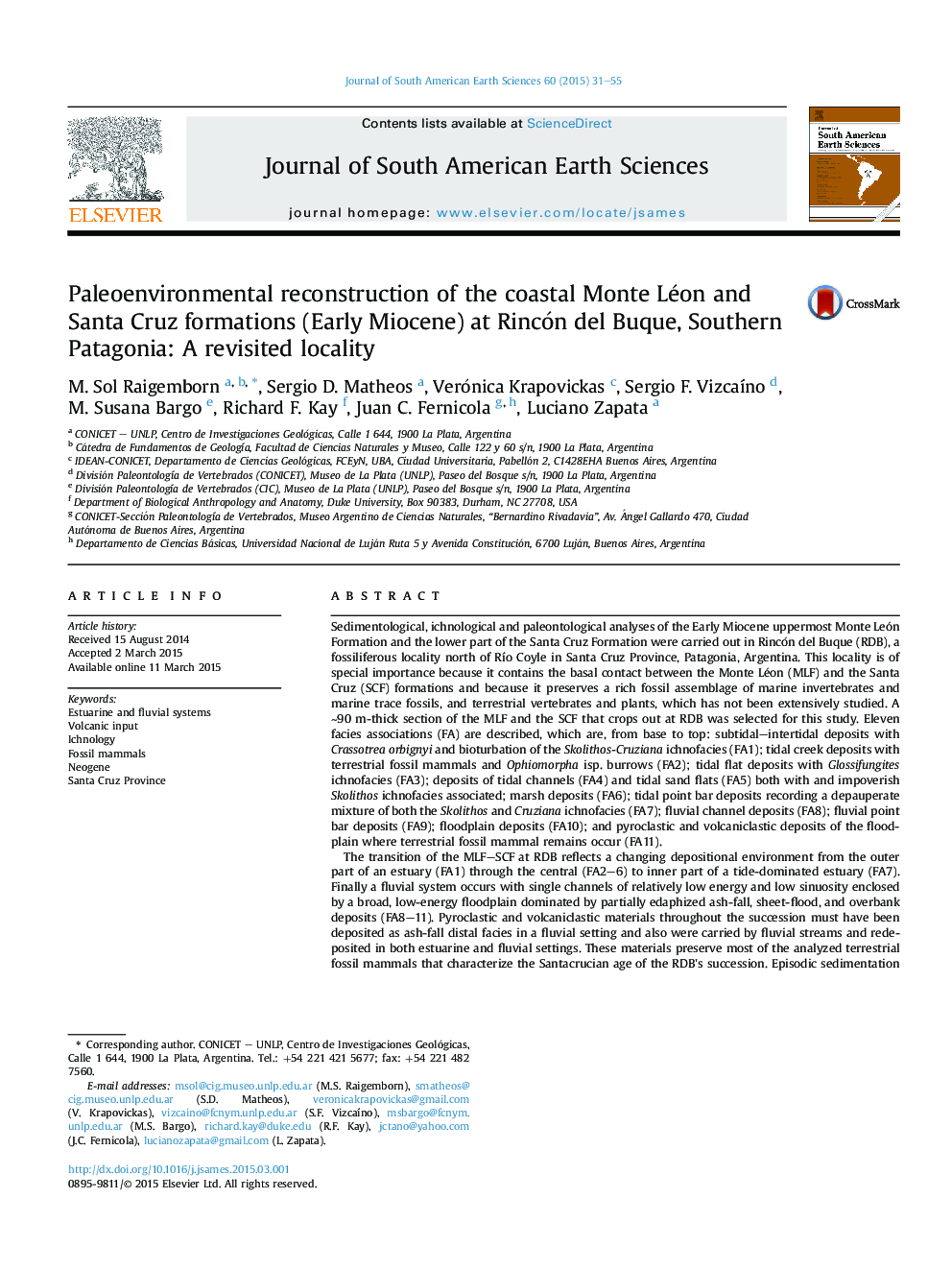| کد مقاله | کد نشریه | سال انتشار | مقاله انگلیسی | نسخه تمام متن |
|---|---|---|---|---|
| 4682054 | 1635149 | 2015 | 25 صفحه PDF | دانلود رایگان |

• Rincón del Buque, a fossiliferous locality of Austral basin, Argentina, is described.
• Uppermost Monte Léon and Santa Cruz formations (Early Miocene) crop out in the area.
• The units include estuarine–fluvial deposits with episodic volcanic influence.
• Marine and terrestrial fauna of Santacrucian age (17.6–17.4 Ma) is mixed at basal SCF.
Sedimentological, ichnological and paleontological analyses of the Early Miocene uppermost Monte León Formation and the lower part of the Santa Cruz Formation were carried out in Rincón del Buque (RDB), a fossiliferous locality north of Río Coyle in Santa Cruz Province, Patagonia, Argentina. This locality is of special importance because it contains the basal contact between the Monte Léon (MLF) and the Santa Cruz (SCF) formations and because it preserves a rich fossil assemblage of marine invertebrates and marine trace fossils, and terrestrial vertebrates and plants, which has not been extensively studied. A ∼90 m-thick section of the MLF and the SCF that crops out at RDB was selected for this study. Eleven facies associations (FA) are described, which are, from base to top: subtidal–intertidal deposits with Crassotrea orbignyi and bioturbation of the Skolithos-Cruziana ichnofacies (FA1); tidal creek deposits with terrestrial fossil mammals and Ophiomorpha isp. burrows (FA2); tidal flat deposits with Glossifungites ichnofacies (FA3); deposits of tidal channels (FA4) and tidal sand flats (FA5) both with and impoverish Skolithos ichnofacies associated; marsh deposits (FA6); tidal point bar deposits recording a depauperate mixture of both the Skolithos and Cruziana ichnofacies (FA7); fluvial channel deposits (FA8); fluvial point bar deposits (FA9); floodplain deposits (FA10); and pyroclastic and volcaniclastic deposits of the floodplain where terrestrial fossil mammal remains occur (FA11).The transition of the MLF–SCF at RDB reflects a changing depositional environment from the outer part of an estuary (FA1) through the central (FA2–6) to inner part of a tide-dominated estuary (FA7). Finally a fluvial system occurs with single channels of relatively low energy and low sinuosity enclosed by a broad, low-energy floodplain dominated by partially edaphized ash-fall, sheet-flood, and overbank deposits (FA8–11). Pyroclastic and volcaniclastic materials throughout the succession must have been deposited as ash-fall distal facies in a fluvial setting and also were carried by fluvial streams and redeposited in both estuarine and fluvial settings. These materials preserve most of the analyzed terrestrial fossil mammals that characterize the Santacrucian age of the RDB's succession. Episodic sedimentation under volcanic influence, high sedimentation rates and a relatively warm and seasonal climate are inferred for the MLF and SCF section.Lateral continuity of the marker horizons at RDB serve for correlation with other coastal localities such as the lower part of the coastal SCF south of Río Coyle (∼17.6–17.4 Ma) belonging to the Estancia La Costa Member of the SCF.
Figure optionsDownload as PowerPoint slide
Journal: Journal of South American Earth Sciences - Volume 60, July 2015, Pages 31–55